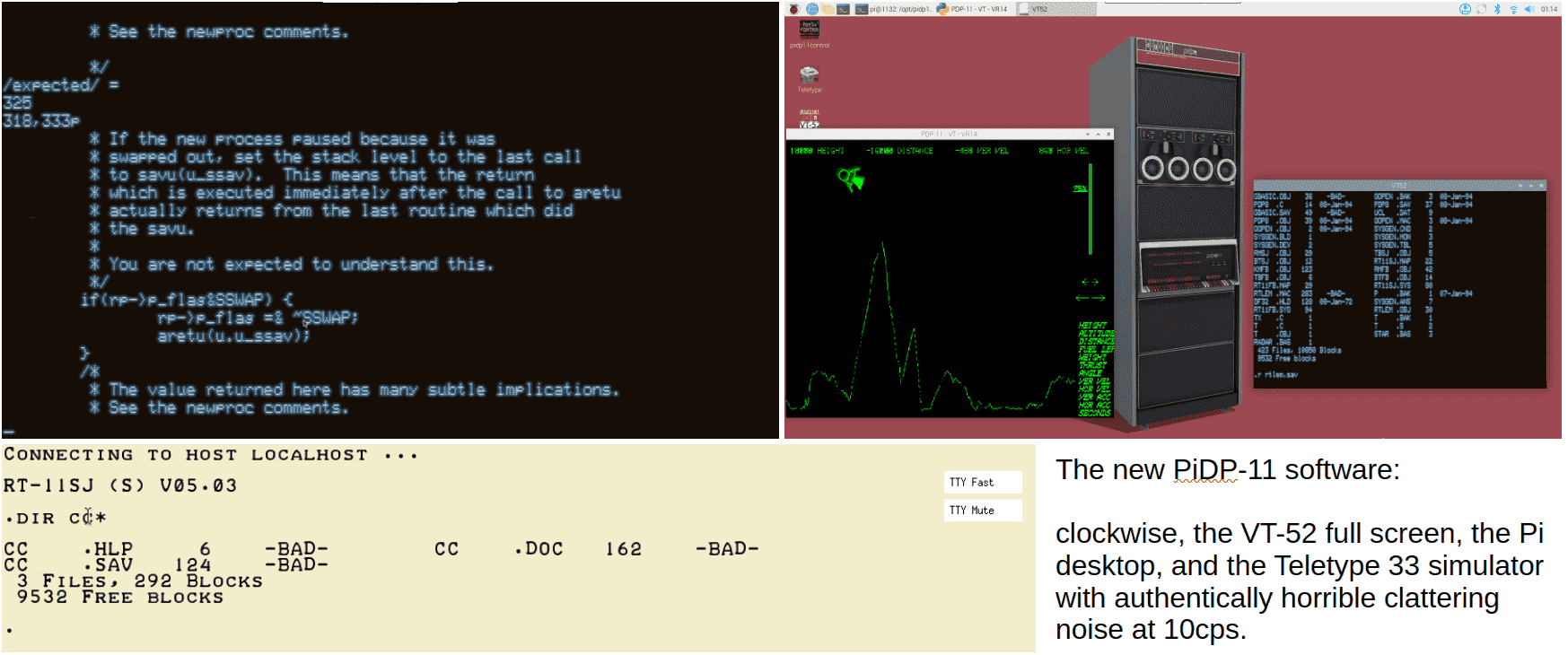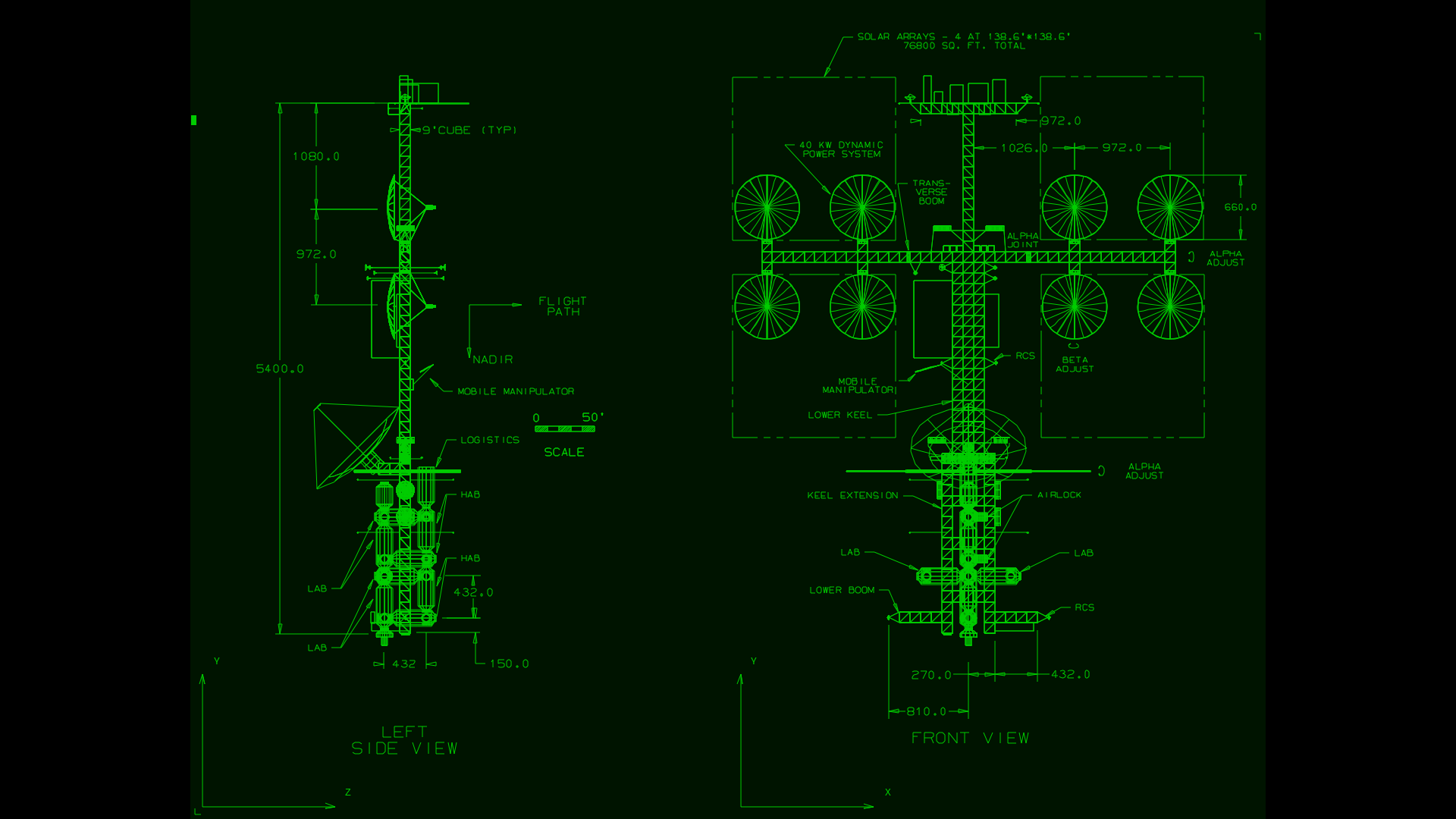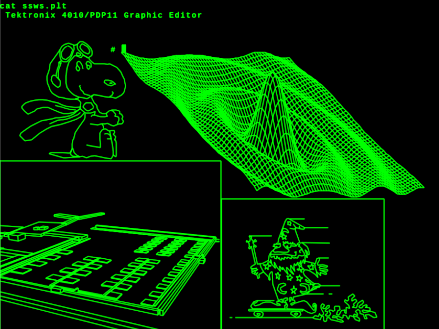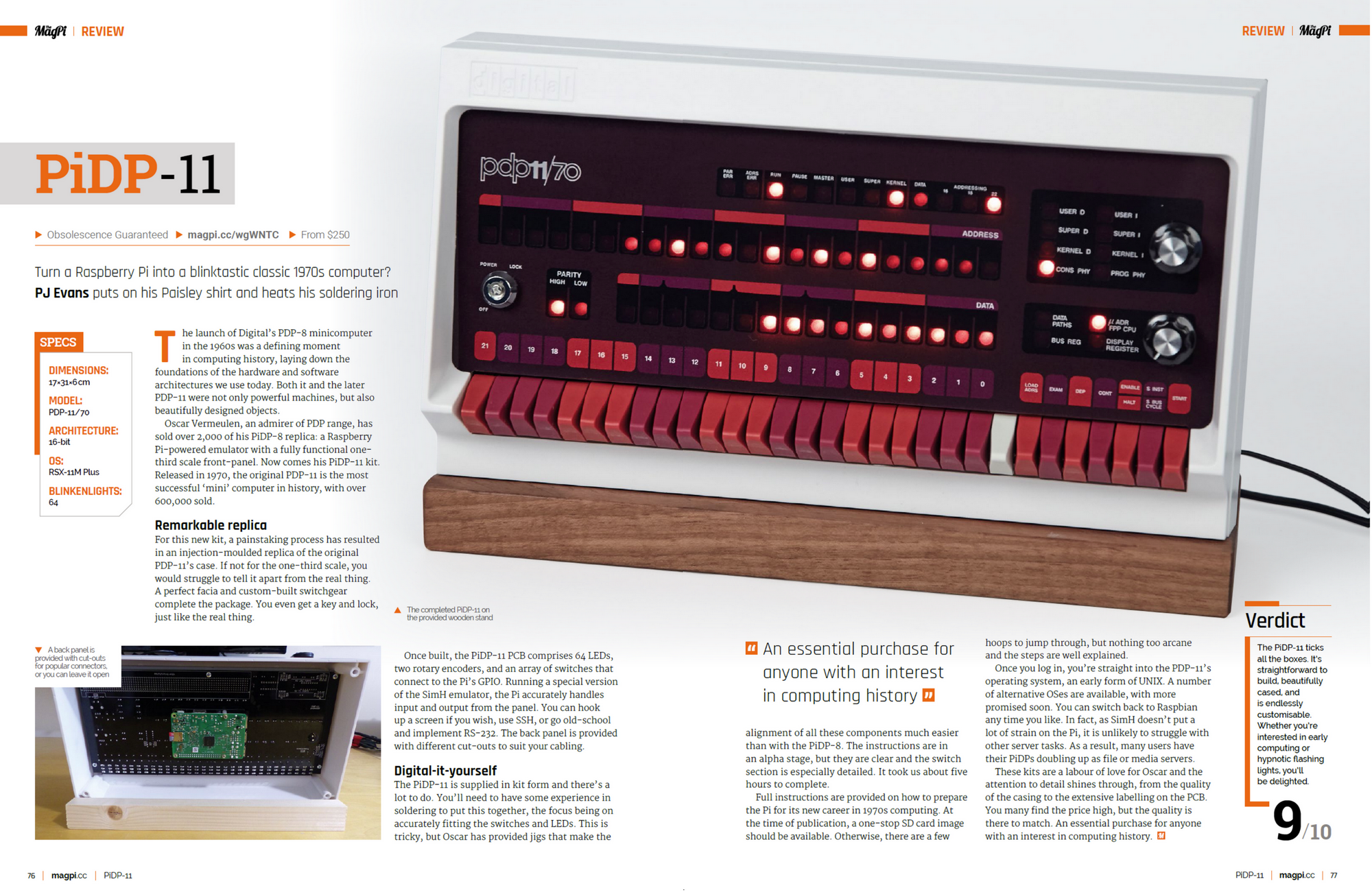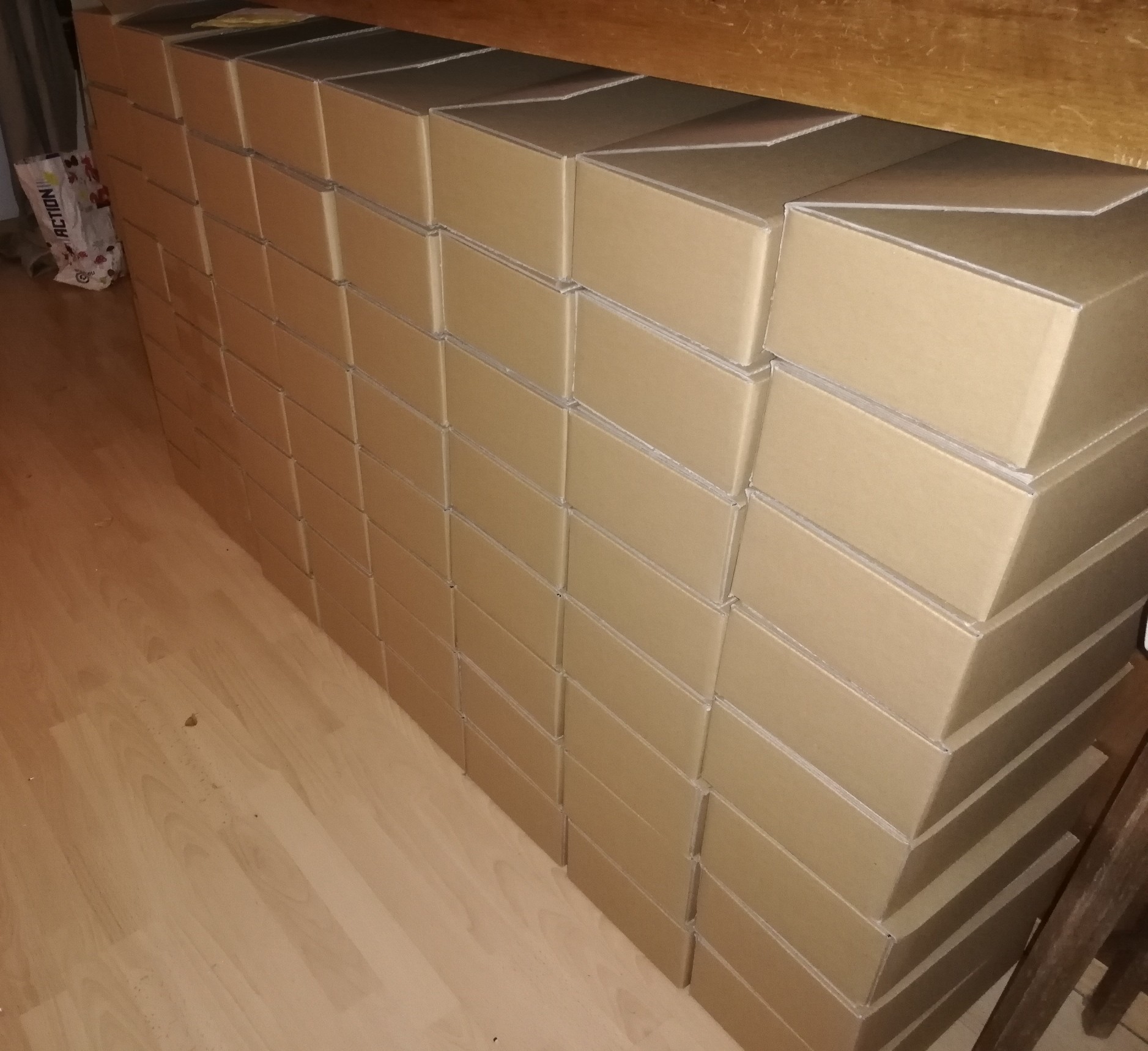-
Update on new developments
06/17/2025 at 01:05 • 0 commentsAs I tend to be a pretty poor communicator, maybe it is good to summarise the PiDP-11 new of last 12 months. From the latest newsletter (link):
- the new software release includes unix v1, much improved 2.11BSD and RSX-11 version, and a very nice VT-52 terminal simulator on the Pi itself, or remote on your laptop if you prefer.
![]()
- Lars Brinkhoff's painstakinly exact VT-100 simulator is perfect for remote connections to the PiDP-11 over wifi:
![]()
- when the new software version is installed, re-run the install script now and then to automatically catch the latest RSX-11 updates from Johnny Billquist.
More news to come this summer :-)
-
Making kits in the jungle - an update after 4 years
08/16/2022 at 15:30 • 0 commentsThe 4000th PiDP-11 kit was sent out last month, which amazes nobody more than me. It has taken over a significant chunk of my life. And I thought it would be fun to write a bit about what you can expect as a Maker when you go into kit making. From what I hear, my experience is not unusual at all.
In the Internet age, no niche is too small. Not even making replicas of a 50 year old computer. Apparently. I thought that I'd make this kit for one or two years, and interest would wane quickly. Not so - four years on, interest in the kit is just the same. The problem is, logistics take over your life once you start making a kit like this. My home started to resemble a live-in factory and neighbours wondered about trucks offloading stuff into my garage...
I had plenty of time over the past few years to do it all myself, as illness in the family made me a full-time carer. In some sense, the timing was perfect. But as (sadly) that carer role comes to an end, I had to think about how I could keep making the kits without it soaking up quite so much time. I'd rather focus on development than on logistics.
So, starting from January, my kit making endeavours move to another phase. A weird one, but that is in line with this whole project. With three friends, production of PiDP-11 kits will become somewhat of a development project in the Panamanian jungle (because, why not, up in the Swiss mountains or down in the Panamanian jungle, same difference). We've set up a micro-factory that will start making a few of my kits and once that is all up and running, could serve as a production base for other Makers as well. Thanks to the Panama Canal and the help of the Panama Postal service, it turns out this is actually an amazingly efficient location logistics-wise. I know, weird idea but so is making PDP-11 clones. And on a small scale, it is pretty cool to think that my Maker activity will provide some useful activity in a small village. To be continued!
-
Finally, a DECtape unit for the PiDP-11
12/22/2019 at 23:51 • 0 commentsWell, a pixelated one.
Rene Richarz just released an animated TU-56 DECTape unit for the PiDP-11. In the form of a rack-mounted HDMI display. Much time was spent thinking of how to replicate a DECtape unit for the PiDP-11, but Rene did what makes most sense: have a high-fidelity DECtape animation instead, on a low-cost HDMI screen.
DECtape was crucial in the early days of DEC, and having a timing-exact virtual unit gives a pretty realistic experience of life before floppy disks:
Thank you, Rene! Apparently, a TU-77 magtape unit is forthcoming. It's a good thing that the new Raspberry Pi 4 has two HDMI outputs.
-
Ancient unix - 2.11BSD updates
09/17/2019 at 21:33 • 0 commentsThe past couple of weeks have seen some interesting developments on the ancient unix side of the PDP-11. We have the high-resolution Tektronix vector display with loads of software and C library of course, the http daemon (running on just simulated 1970s hardware, mind you!) has been boosted with CGI, and quite a few other patches and goodies have been worked on (even the Ingres database has been brought to life).
![]()
Here is the thread with the latest disk image download: (link)
-
Supporting the Pi 4
08/19/2019 at 19:49 • 0 commentsI just updated the firmware to support the new Pi 4, which has a slightly different way of enabling the internal pull-up resistors on the GPIO.
So... where the Pi 3B+ was 6 times faster than the real 11/70 at 7241 dhrystones/second, versus 1250 for the 1975 original... you can now enjoy a 12x speed boost versus 1975. For those who like to be as authentic as possible, use a Pi 2! Or use the 'set throttle' configuration to slow down the Pi 4. Or run multiple 11/70s in parallel. At least the Pi 4 shows there's still progress in computing and 2.11BSD unix feels like lightning :)
The other nice thing of the Pi 4 is that you can use one HDMI display for a faithful CRT display (using cool-retro-term) and a second one for the very cool Tektronixvector tube simulation, which really uses the 4K resolution of the Pi 4:
![]()
-
Building the PiDP-11: Youtube video
05/07/2019 at 15:50 • 0 commentsBeige-O-Vision just made a very nice 4-part Youtube movie showing how to build the PiDP-11. Worth mentioning here, as it surely will save builders a lot of time. Since nobody reads written Building Instructions anymore these days...
The next three parts as Youtube links:
Part 2 (soldering), Part 3 (mounting the switches), Part 4 (wrapping up)
Thank you, Beige-O-Vision!
-
Vector Graphics on the PiDP-11
04/18/2019 at 12:30 • 0 comments[Rene] wrote a very pretty emulator for the Tektronix 4010 vector graphics display. And got everything set up inside 2.11BSD so you can actually use it. It's a great step forward: not only can the PiDP-11 now do vector graphics on BSD, but the C libraries are included as well! It turns out that making cool graphics takes only a tiny bit of C...
![]()
We already had BSD unix networked on the PiDP-11, so this is becoming a pretty top-of-the line scientific minicomputing setup ;)
One of the next challenges is to get uucp going on Unix v7, as a bridge between the Pi and the PDP-11 sides of the PiDP-11... nontrivial.
-
Big Update
01/15/2019 at 23:38 • 1 commentThe new software (and software museum) distribution is currently in beta stage. Use your PiDP-11 with RSX-11 as a web server, surf the internet with 2.11BSD, play lunar lander on a simulated vector display, follow the Lions Commentary on a real Unix v6... things are developing rapidly at the moment.
That is also why the manual is in .odt format. It's being added to constantly. Best opened in MS Word, but LibreOffice on the Pi is OK too. Have a look:
https://www3.ispnet.net/pidp11/PiDP-11%20Manual%20v0.2.odt
This will be an exciting year as the collective effort to polish up the PDP-11 software museum gathers pace. With >800 builders, stuff gets done!
-
MagPi review, real core memory and on to historical Unices
12/22/2018 at 22:10 • 0 commentsMuch has been happening now the hardware is done.
First comes a software update with polished-up boot disk images for unix v5, v6, v7, 2.11 BSD and Ultrix, hopefully next week. Got to do it before January 1st, Unix's 50th birthday!
Then, Jörg has released the UniBone card. This thing lets Linux drive the old Unibus directly. It is possible to have a software CPU simulation run inside an old, potentially dead, PDP-11 and let it use its real core memory as well as any real PDP-11 disks... this needs hooking up to the PiDP :)
Lastly, many thanks to PJ Evans for publishing this article in the latest MagPi edition! Hopefully that gets new people sucked into the dark world of PDP-11 computing.
![]()
(note - MagPi is a truly Open Source publication, Creative Commons (BY-SA-NC 3.0))
-
PiDP-11 Updates
11/22/2018 at 22:48 • 0 commentsWell, today was a great day - the day that the 600th PiDP-11 saw the light of day! I'll celebrate this weekend at the Vintage Computer Festival Zürich (vcfe.ch, that's a shameless plug...)
But there are hardware developments too. Soon, we'll have the PDP2011, Sytse's FPGA version of the PDP-11, as a plug-in module. So you can choose whether you like a Raspberry Pi simulating inside, or a FPGA hardware version to blink the front panel.
And Jörg is cranking out the first production UniBones - a reasonably mad device that can plug in to a real DEC Unibus. Either to emulate any storage peripheral for a real PDP-11, or to hook up any real PDP-11 hardware onto the simh running inside the PiDP-11. Yes, you will be able to connect an RK-05 to the PiDP-11... who'd have thought that two years ago!
Here, somewhere at the end of the last row, is PiDP-11 #600 waiting for the postman. One more grainy late-night picture:
![]()
